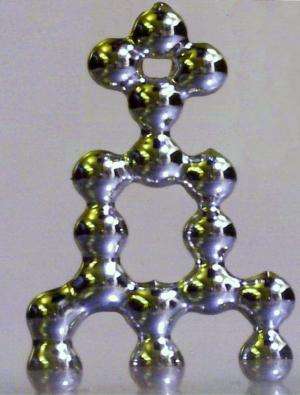Researchers build 3-D structures out of liquid metal

(Phys.org) —Researchers from North Carolina State University have developed three-dimensional (3-D) printing technology and techniques to create free-standing structures made of liquid metal at room temperature.
"It's difficult to create structures out of liquids, because liquids want to bead up. But we've found that a liquid metal alloy of gallium and indium reacts to the oxygen in the air at room temperature to form a 'skin' that allows the liquid metal structures to retain their shapes," says Dr. Michael Dickey, an assistant professor of chemical and biomolecular engineering at NC State and co-author of a paper describing the work.
The researchers developed multiple techniques for creating these structures, which can be used to connect electronic components in three dimensions. White it is relatively straightforward to pattern the metal "in plane" – meaning all on the same level – these liquid metal structures can also form shapes that reach up or down.
One technique involves stacking droplets of liquid metal on top of each other, much like a stack of oranges at the supermarket. The droplets adhere to one another, but retain their shape – they do not merge into a single, larger droplet. Video of the process is available below:
Another technique injects liquid metal into a polymer template, so that the metal takes on a specific shape. The template is then dissolved, leaving the bare, liquid metal in the desired shape. The researchers also developed techniques for creating liquid metal wires, which retain their shape even when held perpendicular to the substrate.
Dickey's team is currently exploring how to further develop these techniques, as well as how to use them in various electronics applications and in conjunction with established 3-D printing technologies.
"I'd also like to note that the work by an undergraduate, Collin Ladd, was indispensable to this project," Dickey says. "He helped develop the concept, and literally created some of this technology out of spare parts he found himself."
More information: The paper, "3-D Printing of Free Standing Liquid Metal Microstructures," is published online in Advanced Materials. onlinelibrary.wiley.com/doi/10 … a.201301400/abstract
Abstract: This paper describes a method to direct-write liquid metal microcomponents at room temperature. 3-D printing is gaining popularity for rapid prototyping and patterning. Most 3-D printers extrude molten polymer that quickly cools and solidifies. The ability to pattern liquids into arbitrary shapes both in and out of plane is usually limited by interfacial tension. A classic example is the break-up of cylinders of liquid into droplets when the aspect ratio of the cylinder exceeds the Rayleigh stability limit of [pi]. Here, we show it is possible to direct-write a low viscosity liquid metal at room temperature into a variety of stable free-standing 3-D microstructures (cylinders with aspect ratios significantly beyond the Rayleigh stability limit, 3-D arrays of droplets, out of plane arches, wires). A thin (~ 1 nm thick), passivating oxide skin forms rapidly on the surface of the liquid metal and stabilizes the microstructures despite the low viscosity and large surface energy of the liquid. The ability to directly print metals with liquid-like properties is important for soft, stretchable, and shape reconfigurable analogs to wires, electrical interconnects, electrodes, antennas, meta-materials, and optical materials.
Journal information: Advanced Materials
Provided by North Carolina State University


















